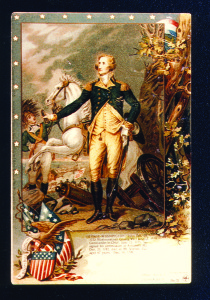Patriotic postcards have long been a favorite topical with many collectors. Always included in this category are the several great historical sets published in the years between 1904 and 1910. These include “Donaldson’s American Heroes,” “Paul Revere’s Ride,” and the two presidential sets by Raphael Tuck & Sons.
But the best of all may well be the 40-card “Colonial Heroes,” which is virtually in a class all by itself.
Published over a century ago, parents and doting aunts and uncles bought them as surprise gifts for boys and girls as a reminder of their great American heritage. Teachers found the postcards useful as educational aids; they also handed out sets as rewards to deserving scholars at the end of the school year.
Specialized postcard shops, which flourished in many cities and towns in the years before World War I, and lavish postcard departments in large retail stores, sold them. Intended as gifts and patriotic souvenirs for Americans of all ages, hundreds of thousands, if not millions, of boxed sets were printed. Because of Independence Day, July was the peak month for sales.
The set depicts early American history with famous paintings, new illustrations, and historical motifs. The concept behind it, combined with the beauty of color lithography done by the German firm of Lange and Schwalbach, makes it unbeatable as a patriotic collectible.
The series begins with the “Landing of the Pilgrim Fathers” (No.2) and goes through the French-Indian Wars and then the American Revolution, finishing with “Washington’s Reception at Trenton. April 21, 1789” on his way to be inaugurated as our country’s first president (No. 40).
The majority of the cards relate to events leading up to the call for independence, such as the “Boston Tea Party,” and “Burning of Stamp Act,” as well as the actual conflict itself, well represented by “Evacuation of Boston,” and “Parade at Yorktown” (after the surrender of Cornwallis). Not only is there a scene of “Franklin’s First Audience” at the Court of St. James, but also a number of fascinating drawings of the armies involved, including “Hessian prisoners,” “Debarkment of French Relief Troops,” and “British Troops.”
Topping it all off are postcards like No. 21, “The Star Spangled Banner,” portraying Miss Liberty carrying an early American flag, the Great Seal of the United States, the special medal struck by Congress, and two stanzas of our national anthem. The card also serves as an index for the last 20 cards of the set. Likewise No. l, an index for the first half of the set, is covered with replicas of Continental currency, another special medal, and more symbols of our country.
Early colonial history is well represented by “William Penn’s Treaty with the Indians,” and several of the early Revolutionary War battles, including a montage of fallen colonial militia leaders.
Most collectors first attempting the “Colonial Heroes” set tend to be confused by the multiplicity of different backs found on the cards. Actually the title itself appears on only one of the printings and is missing from all others. Some people have long called it the “American Historical Art” set, a description derived from the publisher’s imprint, which is found on every card of every printing.
There were four separate and distinguishable publishings of this group of postcards, though each ran through numerous printings. They were marketed in complete sets only, corning packaged inside of a hard cardboard box, which itself is quite lovely and collectable. The front shows an eagle riding atop a shield with two flags behind it. It is titled “History of the United States. Colonial Times and the War of Revolution.” The promotional goes on to say: “Collection of Authentic pictures from the best American, English, French, and German artists.”
The publisher of the “Colonial Heroes” set, American Historical Art Publishing Co., had offices in both New York City at l14 East l4th Street and in St. Louis, Missouri (813 Chestnut Street). The postcards were copyrighted in 1903 and first sold at the Louisiana Purchase Exposition in St. Louis the following year.
The earliest set was printed on “Private Mailing Card” backs. Since PMC’s went out of style in 1905 with the introduction of the undivided postcard back, it can be assumed that 1905 was the latest possible year for this first printing. Inexplicably, some printings were-labeled “Series I,” and others “Series II.” This same confusion continued with subsequent production runs.
The third publishing was on divided back stock. The fourth and last, also with divided backs, is titled “Colonial Heroes,” and omits completely the name of the printer, Lange and Schwalbach.
Regardless of the specific printings, each set has 40 cards, the same 40 illustrations found in all sets. Also, individual card numbers remain the same in all groups.
Prices currently range from $15 to $25 for each postcard of the set. One problem does seem to keep popping up and this is one of condition. A significant number of the postcards have paper attached to the face, probably interfacing sheets from unsold stock.
Another hallmark of these cards is that a used copy is quite uncommon, reinforcing the theory that the “Colonial Heroes” cards were meant to be saved and cherished, rather than dropped into a mailbox.
In all, nearly 175 years of American history is covered by the 40 superb postcards found in this set. It was truly a patriotic salute by the publisher and a priceless collectible for future generations.
















Follow Us